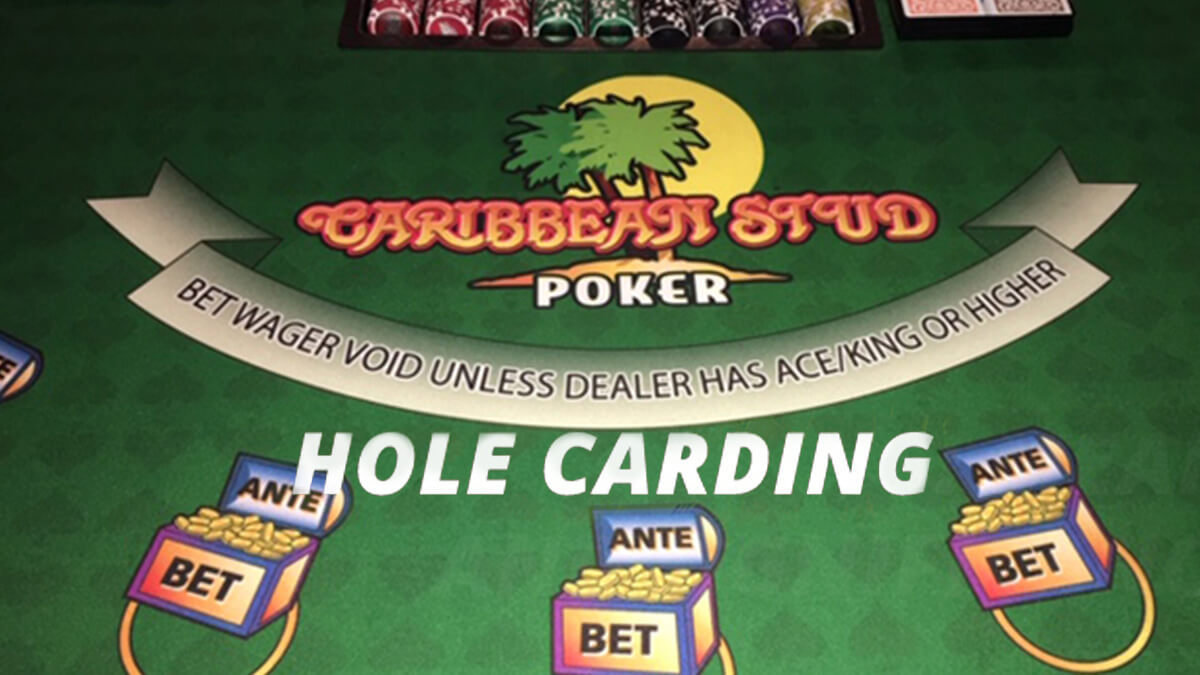Like blackjack, Caribbean stud isn’t typically a beatable game. Instead, it’s normally one of the worst casino games regarding profit potential.
Even with perfect basic strategy, you’re facing a 5.22% house edge in Caribbean stud. This house advantage is worse than what’s seen on average with blackjack (1.0%), baccarat (1.06%), craps (1.36%), and European roulette (2.70%).
Therefore, it doesn’t seem like advantage play would help you much with this game. But you can actually gain the edge over casinos with hole carding.
Assuming you’re unfamiliar with hole carding, you can read more about this advantage technique below. I’ll also cover how it can help you beat Caribbean stud.
What Is Hold Carding?
A Caribbean stud hand begins as follows:
- You place an ante bet along with an optional jackpot wager.
- The dealer will deal you five face-down cards; you’re not supposed to show these cards to anybody else at the table.
- The dealer also receives four face-down cards and one upcard.
- You must decide whether to raise (2x ante) or fold.
You base the decision to raise or fold on your five-card hand and the dealer’s upcard. The hope is that you raise and beat the dealer to win your ante. Meanwhile, the raise payout depends upon a pay table provided by the casino.
In any case, you’re not supposed to see any of the dealer’s four hole cards. This incomplete information makes it tougher for you to beat the croupier’s hand and heavily contributes to the 5.22% house edge.
But what if you could see one or more of the dealer’s face-down cards? You’d have more information to go off of and make better decisions as a result.
Hole carding is the process of trying to see the croupier’s hole cards in a table game, such as Caribbean stud. The goal is to find a dealer who routinely shows their hole cards without realizing it (i.e. flasher).
Most croupiers are well trained and rarely flash their card values. However, you may occasionally find a flasher that gives you an advantage.
The biggest element to this strategy is actually discovering a dealer who’s inexperienced and/or bad enough to show their face-down cards.
You’ll need to look far and wide to locate such a croupier. The search can be well worth the effort in the end, though.
When looking for flashers, you should choose a seat that gives you a reasonable chance to see the dealer’s hole cards. Basically, you when to sit in either the first or last seat.
A Caribbean stud dealer typically puts the shoe on the opposite side of their dominant hand. They pull cards out with their non-dominant hand and slide them into position with the dominant hand.
By sitting on the shoe side, you can potentially see a glimpse of the hole cards as the dealer pulls them out. Your hope is that the croupier slides the cards into position and accidentally shows one or more in the process.
Here’s where you want to sit when hole carding in Caribbean stud:
- Shoe on the dealer’s left (most common) – Sit in the first seat to the dealer’s immediate left (a.k.a. first base).
- Shoe on the dealer’s right – Choose the first seat to the croupier’s immediate right (a.k.a. third base).
One final note here involves how you look at hole cards. You want to sit in a low position that looks fairly natural.
Being lower to the table gives you a better chance to spot hole cards. As long as you look natural, the casino won’t be suspicious either.
How Do You Apply Hole Carding to Caribbean Stud?
When done perfectly, you can gain an 11% edge over the house through Caribbean stud hole carding. This is the same advantage that casinos hold over players with penny slot machines!
Unfortunately, you probably won’t find the perfect conditions that allow you to benefit from such a huge edge. But you can at least gain an advantage of some sort with the right approach.
The first matter involves finding a consistent flasher. Again, most dealers have enough training to where they won’t flash many card values.
However, you may be able to find a poorly trained/skilled croupier if you search hard enough. You’re specifically looking for somebody who shows one or more of hole cards when sliding them out of the shoe.
Ideally, the dealer will be so bad that they’re showing glimpses of 2-4 cards when sliding them out. But you can settle for 1-2 cards every hand and still win.
Caribbean stud games aren’t as prevalent as blackjack tables—another great game for hole carding. Therefore, you should seriously consider looking for bad dealers in Las Vegas.
Sin City offers over 130 casinos, with many running three shifts. This large number of casinos combined with multiple shifts gives you a stronger chance to find flashers.
The next matter involves applying the information you gain from errant hole card flashes. Caribbean stud features basic strategy that can help you minimize the house advantage to 5.22%.
A big reason for the large house edge is that you can only see one upcard from the dealer. The entire point of using this advantage gambling technique is so that you can uncover more dealer cards.
Here’s an example of what to do with this info:
- Common strategy suggests to only raise with A-K-J-8-3.
- The dealer needs A-K-4-3-2 or better to qualify.
- You hold A-K-J-8-2 and would normally fold in this situation.
- But while hole carding, you see the dealer flash 3, 4, and 7.
- Their upcard is 2.
- You now know four of the dealer’s cards, including 2-3-4-7-X.
- The dealer could pair one of their cards and beat you.
- However, they most likely don’t have a qualifying hand here.
- You should raise in this situation.
Will You Ultimately Be Successful with Hole Carding?
This advantage play technique is one of the toughest to pull off in gambling. It requires spending hours looking for an inexperienced dealer who’ll unknowingly give away information.
Your search for a flasher will turn up empty time and time again. Therefore, you may feel like giving up before your hard work pays off.
However, hole carding is still a legitimate way to beat Caribbean stud. It’s also a perfectly legal gambling strategy too!
To recap, you want to live in, or at least frequently visit, Vegas if you’re serious about beating this game. No other gambling destination offers anywhere near the amount of stud tables as Sin City.
You should prepare to search for the perfect dealer for days or even weeks. Finding a flasher can feel like looking for a needle in a haystack.
Once you find such a dealer, though, your efforts can really pay off. This is especially true if the croupier consistently shows face-down card values.
Besides looking for a bad dealer, you must also think about what to do with information you gain. This matter requires understanding basic strategy (which is pretty easy) and varying your play based on flashed hole cards.
I can’t say for sure whether you will or won’t beat Caribbean stud when hole carding. However, you stand a better chance of doing so when you put more effort into the matter.
Are There Any Other Legal Ways to Beat Caribbean Stud?
Theoretically, you can beat stud in many ways. You could hide cards in your sleeves, mark cards with invisible ink (requires special contacts), and collude with the dealer.
Of course, these methods are illegal and could result in jail time. Moreover, you’re probably going to be caught sooner or later when using them.
You may wonder if there are any other legal strategies for beating Caribbean stud besides hole carding. I don’t know of any techniques that are 100%, undeniably legal—other than perhaps taking advantage of a faulty deck (a rare occurrence).
Player collusion may or may not be legal in certain gaming jurisdictions. By legal, I mean that the casino won’t prosecute you after throwing you and your buddies out.
Collusion involves players sharing information on aces, kings, and cards that match the croupier’s upcard. Each player can then make better decisions when raising/folding.
A full table (seven players) can gain a 2.38% advantage over the house with perfect collusion techniques. However, six players working together will still be facing a 0.4% house edge at best.
That said, a key component of this strategy is to fill the entire table with colluders. The second part is to use James Grosjean’s MAK system when working together.
MAK refers to:
- Matches – A team will have from 0-3 cards that match the dealer’s upcard.
- Aces – Players can collectively hold 0-4 aces.
- Kings – A team can collectively hold 0-4 kinds.
This system calls on each team member to raise when:
- M is 0, and they hold a higher pair than the dealer’s upcard value (e.g. 7s vs 4 upcard).
- M is 3, and A + K is 7 or 8.
Players of course need to work out an elaborate system to communicate their information with each other. They must develop physical tells to let others know what they have.
Again, I can’t be 100% certain that collusion is legal in your gambling jurisdiction. But it has a better chance of being legal than blatant cheating, like slipping aces into your hand or marking cards.
Conclusion
Caribbean stud is one of the toughest games to beat from a house edge perspective. The casino holds a 5.22% advantage over you even when basic strategy is used.
However, you can turn the tables through hole carding. The latter involves finding a dealer that flashes their face-down cards (on accident) and capitalizing on this information.
Not many dealers are this poorly trained. But you may be able to find one or more by searching the many casinos throughout Las Vegas.
Michael Stevens
Michael Stevens has been researching and writing topics involving the gambling industry for well over a decade now and is considered an expert on all things casino and sports betting. Michael has been writing for GamblingSites.org since early 2016. …



